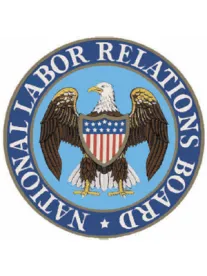In its 84-year history, the National Labor Relations Board (NLRB, Board or Agency) has promulgated a very small number of rules pursuant to the Administrative Procedures Act, relying, instead, on individualized adjudications to establish the Board’s legislative policies. However, breaking with that long tradition, the current Board now appears to be on the verge of a formal rulemaking jag for on May 22, the Board released its “Unified Agenda” of anticipated regulatory actions which, in addition to proceeding with rulemaking regarding joint employer standards, announced the Board’s intention to consider formal rulemaking in a number of critical areas. Consistent with that wide-ranging Agenda, on August 12, the Board published a Notice of Proposed Rulemaking (NPRM) over the objection of Democratic appointee, Lauren McFerran, that would amend the Agency’s rules and regulations governing the filing and processing of election petitions in three very important ways. This NPRM, therefore, deserves attention.
The first possible amendment will modify the Board’s administrative election blocking charge practice by establishing a regulation-based vote and impound procedure to be used when a party, typically a union facing possible decertification, files an unfair labor practice (ULP) charge and, based thereon, seeks to block the holding of an election.
The second possible amendment will modify the Board’s current recognition bar case law by codifying prior Board case doctrine and creating a regulation-based requirement of notice of voluntary recognition to affected employees and a 45-day open period within which affected employees may call for an election before that voluntary recognition will be allowed to operate as a bar to employees raising later questions concerning the union’s representative status (QCR).
Finally, the third possible amendment would overrule current Board case law holding that collective bargaining language in the construction industry, standing alone, can be legally sufficient to prove a union’s majority status and establish a conventional 9(a) bargaining relationship between an employer and its employees’ union (9(a) relationship). Under this new regulation-based amendment, to prove the establishment of a 9(a) relationship in the construction industry, extrinsic evidence, typically in the form of employee signatures on authorization cards or a petition, must be presented and show that recognition was based on a contemporaneous showing of majority employee support. Absent such extrinsic proof, the relationship that exists between a construction employer and a construction union will be deemed to be a prehire relationship under the Act’s Section 8(f) that is terminable at will by an employer at the expiry of a construction labor agreement (8(f) relationship).
If and when they are promulgated, these proposed changes (and the several others also apparently soon to follow) promise to materially reshape federal labor law, to substantially affect the rights, duties and opportunities of employers and to diminish the fortunes of organized labor.
The NLRB’s Rulemaking Has Remained Long and Largely Underused
Section 6 of the National Labor Relations Act (NLRA or Act) authorizes the Board to make such rules and regulations “as may be necessary to carry out the provisions of the Act” in accordance with the Administrative Procedures Act (APA). With this language and except as expressly prohibited by the statute, Congress has authorized the Board to “legislate” substantive policies that put meat on the Act’s statutory bones. These rules are given the force of law. The virtues of the rulemaking process are manifest by resulting in the issuance of a generally applicable rule of law and provide greater certainty, clarity and enforcement uniformity. Indeed, once a substantive legislative rule is put in place, agencies are not free to ignore or overrule it in a subsequent adjudication. Instead, they must engage in a new rulemaking process overturning a prior rule. Moreover, rulemaking is not dependent on the participation and arguments of parties in a specific case. With its broad public notice requirements and because it offers greater opportunities for public input, rulemaking provides an agency with greater information gathering and is fairer to the broad class of parties who will be affected by a new rule.
Alternatively, the Act’s Sections 9 and 10 authorize the NLRB to adjudicate representation and unfair labor practice cases and to establish its policies by precedent-setting adjudications. Like legislative rules issued pursuant to the APA, final adjudicated orders also have the force of law unless they are denied enforcement by the court. However, they are more easily overturned or modified since they may be reversed by a subsequent adjudication enunciating new or contrary Board policies.
Absent a statutory mandate to the contrary, administrative agencies have the discretion to decide whether to formulate policy through rulemaking or adjudication. The NLRB is no exception. It too has discretion to determine whether and when it will use the two policy making vehicles. However, unlike most other federal administrative agencies, the Board has rarely engaged in substantive rulemaking, relying instead on the ad hoc adjudicative process to fashion and regularly refashion (and re-refashion) its policies and to vary the Act’s application from one presidential administration to the next. These frequent policy oscillations have led to administrative uncertainty and caused both courts and commentators to criticize the Board over its failure to make a greater use of rulemaking.
A Description/Explanation of Each of The NLRB’s Proposed New Rules
Possible Rulemaking Substituting a Vote and Impound Procedure for the Board’s Current Blocking Charge Policy
Almost since its inception, the NLRB has maintained a policy of permitting a party – typically a union and most often in response to a decertification petition – to block the holding of an election indefinitely by the mere filing an unfair labor practice charge that creates some question as to the validity of the petition or the ability of employees to make a free and fair choice concerning representation while the union’s charge(s) remained unresolved. The net effect of this policy has been to unnecessarily delay the prompt resolution of QCR’s and to deprive workers of their rights under the law through prolonged delay. Indeed, as the Board noted in its NPRM, statistical studies show that the effect of this policy has been to preclude the holding of petitioned-for elections for months and even years, especially when incumbent unions manipulated the policy to protect their incumbency by filing consecutive unmeritorious charges over a long period of time. Moreover, the Board acknowledged that concerns have been raised about the Agency’s regional directors not applying the blocking charge policy consistently, thereby creating uncertainty and confusion about when, if ever, parties can expect an election to occur.
Because of these concerns while, at the same time, also wanting to protect employees from possible employer unfair labor practices, the Board’s General Counsel has proposed and the Board is now seeking public comment on a formally adopted vote-and-impound regulation requiring that an election be held regardless of whether a blocking charge and blocking request are pending and the ballots be impounded until the merits and effect of a ULP charge are determined.
Possible Rulemaking Modifying the Current Immediate Voluntary Recognition Bar Doctrine and Reinstating the Board’s Earlier Holding in Dana Corporation
It has long been lawful for an employer to voluntarily recognize a union based on the union’s proof of majority support. Moreover, beginning in 1966 with a case known as Keller Plastics, 157 NLRB 583, the Board has held that an employer’s lawful voluntary recognition of a union immediately barred the employer and/or its affected employees from raising a question concerning the union’s representative status for “a reasonable period of time.” The theory underlying the immediate voluntary recognition bar doctrine was that federal labor policy favors the maintenance of industrial peace through collective bargaining and that once a bargaining relationship is rightfully established, it must be permitted to exist without challenge and to function for a reasonable period in which it can be given a chance to succeed.
In 2007, in Dana Corporation, 351 NLRB 434, a Republican Board majority elected to revisit and eliminate the immediate recognition bar doctrine. Citing the statute’s preference for Board conducted secret ballot elections to resolve QCR’s and the benefits derived therefrom, the Dana Board held that there could be no voluntary recognition bar unless and until affected employees were first given notice of the employer’s voluntary recognition and afforded a reasonable opportunity lasting 45 days from the time of notice to file an election petition and question the union’s majority status in a Board conducted secret ballot election. After that and assuming that either no election petition was filed or the union won a subsequent election, a bar to raising a QCR would come into being, precluding any challenge to the union’s majority for a period of at least one year.
That Dana may have been rightly decided is demonstrated by the statistics that follow. During that time, the NLRB received more than 1,300 requests for Dananotices. In those cases, employees filed 102 election petitions and 62 elections were held. In 17 of those elections, the employees voted against continued representation by voluntary recognition. Despite this experience, four years later, a newly appointed Democratic Board-majority overruled Dana in Lamons Gasket, 357 NLRB 739 (2011) and reinstated the immediate voluntary recognition bar as the controlling law. Compounding the effect of this development is the fact that if, during the immediate recognition bar period, the bargaining parties conclude a contract, then that contract may serve as an additional bar, known as the “contract bar” for periods of up to three years, meaning that employees may be locked into union representation for up to four years simply because they had no opportunity to weigh in on the issue of union representation at or about the time of voluntary recognition. Because of this, the Board is seeking public comment on a formal rule that would codify Dana’s holding, rendering it immune to change by the Board’s adjudicative process.
Possible Rulemaking Precluding Construction Unions from Claiming Perpetual Bargaining Relationships in the Absence of Actual Proof of Majority Support
The relationship that exists between an employer and a union that, in fact, represents the employees in an appropriate bargaining unit is referred to as a 9(a) relationship, taking its name from that Section of the NLRA that grants to majority unions the legal right to represent employees. A lawful 9(a) bargaining relationship is perpetual, meaning that once begun, the relationship continues indefinitely and an employer may not lawfully withdraw from that relationship unless and until a majority of its employees indicate that they no longer wish to be represented by the union, the union disclaims interest in representing the employees or the employer or the union cease to exist. As a general rule, an employer may not recognize and bargain with a union that does not enjoy majority employee support. Indeed, the Act’s Sections 8(a)(2) and 8(b)(1)(A) make it unlawful for an employer and a minority union to bargain collectively. Moreover, according to the Supreme Court, labor contracts entered into by and between employers and minority unions are void and unenforceable. Section 9(a) and this ban on minority bargaining are the rules of law that apply to all covered private sector employers here in the U.S. except for those in the construction industry.
The Act’s Section 8(f) is a special statutory carve out created for the construction industry based on the peculiar employment characteristics and bargaining relationships in that industry. Unlike other covered employers, Section 8(f) permits employers and unions in the construction industry to establish a collective bargaining relationship in the absence of majority support. However, under 9(a) relationships, these 8(f) bargaining relationships do not run for indefinite periods and they are not perpetual for once a construction labor agreement governed by Section 8(f) expires, a construction employer is free to repudiate the bargaining relationship it has with a construction union provided the union has not proven its majority status. Accordingly, whether and when a relationship that exists between a construction industry employer and a construction industry union is governed by Section 9(a) or Section 8(f) has been a hotly contested issue over the years because a union with an 8(f) relationship may find itself left in the cold at the end of a construction labor contract.
In Staunton Fuel, 335 NLRB 717 (2001), a Democratic Board held, for the first time, that a construction industry union could prove 9(a) recognition on the basis of a contract’s language alone without any additional or positive evidence of actual majority support, provided the contract language indicated that 1) the union requested recognition as the majority representative of unit employees; 2) the employer “recognized” the union as a 9(a) representative; and 3) the employer’s recognition was based on the union having shown or offered to show the employer evidence of its majority support. Even though Staunton’shas been much criticized and denied by the United States courts of appeals in later cases, the Board has adhered to it, holding that certain contract language, standing alone, is legally sufficient to establish a 9(a) relationship in the construction industry.
The problems with the Staunton Fuel approach are several. Given the Act’s underlying emphasis on majoritarian rule, the proposition that contract language standing alone can establish a 9(a) relationship runs roughshod over employee rights since an agreement between an employer and a minority union is void and unenforceable. Indeed, even though Section 8(f) creates a limited construction industry exception to the general rule prohibiting pre-hire agreements, it also explicitly preserves to employees the right to designate or “un”-designate their bargaining representatives during the term of a pre-hire contract. Accordingly, absent positive proof of a union’s actual majority status, how can contract language, standing alone, possibly be sufficient to prove the union’s majority support? It can’t. And it is for that reason that the current NLRB is seeking public comment and considering the issuance of a formal rule overruling Staunton Fuel and requiring construction industry unions to present positive proof of actual majority support as a condition of establishing a perpetual 9(a) bargaining relationship instead of an 8(f) relationship that may be terminated at will at the end of a construction industry labor agreement.
Takeaways
These three changes are but the first of many soon to follow. The current Republican-controlled Board is bound and determined to reverse what it considers to be the many pro-labor excesses of the Obama Board. Absent Congressional amendments to the Act, the current Board’s rulemaking initiation will make a return to Obama Era doctrines by adjudication impossible should the Democrats regain control of the Agency.
Aside from the three changes referenced in this most recent NPRM, the NLRB will likely soon make modifications in the following substantive areas by APA rulemaking:
-
Reversal of the Browning Ferris decision and a return to the Board’s traditional treatment of joint employer issues;
-
A change in the Board’s Election procedures/timelines giving employer’s more time to react to and campaign against union representation;
-
Reversal of the Columbia University decision and a return to the Board’s traditional treatment of graduate students as non-employees; and
-
Unions’ rights to gain access to private property.





 />i
/>i

